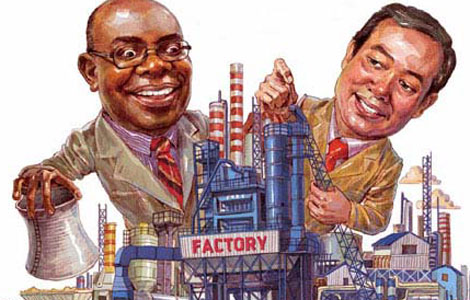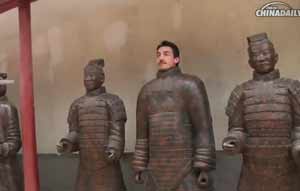Treading the thin red line of reform
Updated: 2013-07-19 09:16
By Zhou Feng (China Daily)
|
|||||||||||

Robust fundamentals give chinese policymakers comfort over full-year targets
The slower growth in the second quarter of the year has once again highlighted China's determination to focus on economic reforms rather than growth. For the record, GDP growth in the second quarter slowed to 7.5 percent, the weakest in several years.
Although the government has set the yearly growth target at 7.5 percent, Premier Li Keqiang has indicated that he is tolerant toward slower growth. Some economists suggest that a growth rate of around 7 percent would be the bottom line the premier is looking at.
But it seems that GDP is not the only, or the most important, indicator the premier takes note of when it comes to policies. My sense is that the premier, who is not as GDP-sensitive as his predecessors, is anchoring to two "red lines" to map out his policies. So long as these two red lines are not crossed, the central government is expected to continue to accelerate structural reforms and refrain from stimulating growth, regardless of how deep the slowdown is.
The question then is: What the red lines are?
To be specific, the first red line is systematic financial stability, and the other is a healthy job market.
Judging from the latest data and market surveys, there is no evidence that the Chinese economy is inching toward or crossing either of the two lines.
On the financial front, despite the de-leveraging effort by the central government and the recent credit crunch that swept the interbank system, a massive liquidity crisis and systematic default are not a threat.
Liquidity remains ample. Total social financing amount, a broad measure of liquidity conditions that includes bank loans and bond sales, stood at 1.04 trillion yuan ($169.5 billion, 128.9 billion euros) in June. Liquidity is regarded as rich when it exceeds 900 million yuan.
The bad loan ratio rose to 1 percent in the first half of the year, still within the "very safe" range. Considering Chinese banks' rich provision and the country's high savings rate, the risk of a systematic financial crisis is low.
In addition, given the country's capital account curbs and its capital flow controls, China can well protect itself in case of another global financial meltdown.
The biggest worry in the financial sector seems to be growing local debts, as the National Audit Office has recently warned that some local governments are repaying debts through new loans.
But the risk, if any, is expected to be limited. Despite slower growth, authorities in affluent regions such as the Pearl River and the Yangtze River delta regions can easily mitigate the problem by restructuring debts and prolonging repayment dates, if necessary.
In less developed regions and areas that went on a credit binge in the past few years, the situation will be slightly more difficult. But the local governments there can still repay the debts by tightening their belts.
As for the job market, the massive layoffs witnessed during the 2008 global financial crisis are unlikely to happen.
It is no exaggeration to say that job supplies in China are more than adequate. New jobs are continuously created against the backdrop of an economy that is still growing. Meanwhile, the labor force, as a whole, is declining amid an aging society, as can be shown by last year's first decline in the number of working-age people.
In this sense, unemployment should not be an issue for China.
The problem that lies ahead for the Chinese job market is the mismatch of different groups of labor forces.
For workers holding senior high school degrees or below, the demand-supply ratio stands at 1.2 times, meaning there are more openings than workers. This set of people mostly work in manufacturing and low-end services sectors.
But for people having bachelor's or associate degrees, the ratio is less than 0.9 percent, reinforcing the statement that this year is the toughest job-seeking season for fresh graduates. This category mostly works in the services sector.
This mismatch has happened because China, reliant largely on manufacturing and exports, has failed to develop its services sector to catch up with demographic changes.
What the government is doing now is to solve this problem. It aims to let the economic slowdown propel the upgrade of the economy.
When the economy grows very fast on the back of easy credit and policy support, business owners' motivation to spend on R&D, innovation, brand building and human resources training wanes. If money can be easily earned by taking advantage of cheap labor, who would bother to improve efficiency and quality?
But in a slower-growth period, they will have to protect the market by staving off competition. Low-end manufacturing businesses will eventually give way to those successful in moving up the value chain.
In this evolution, social and economic resources will flow quickly to high-quality businesses, reducing the mismatch that has existed in financial and labor markets. Business closures will be common in this process, but Chinese businesses' resilience and ability to adapt has been impressive.
The ratio of profits to cost of Chinese companies, a gauge of profitability and efficiency, stood at about 6 percent in June. Considering the ratio was between 6 to 8.5 percent even during the two best periods, 2003-08 and 2010-11, the June reading, against the backdrop of a multiyear low economic growth, is good enough.
This is clear evidence that the Chinese economy can withstand a seemingly deeper slowdown.
The author is a financial analyst in Shanghai. The views do not necessarily reflect those of China Daily.
( China Daily European Weekly 07/19/2013 page10)
Today's Top News
List of approved GM food clarified
ID checks for express deliveries in Guangdong
Govt to expand elderly care
University asks freshmen to sign suicide disclaimer
Tibet gears up for new climbing season
Media asked to promote Sino-Indian ties
Shots fired at Washington Navy Yard
Minimum growth rate set at 7%
Hot Topics
Lunar probe , China growth forecasts, Emission rules get tougher, China seen through 'colored lens', International board,
Editor's Picks

|

|

|

|

|

|





